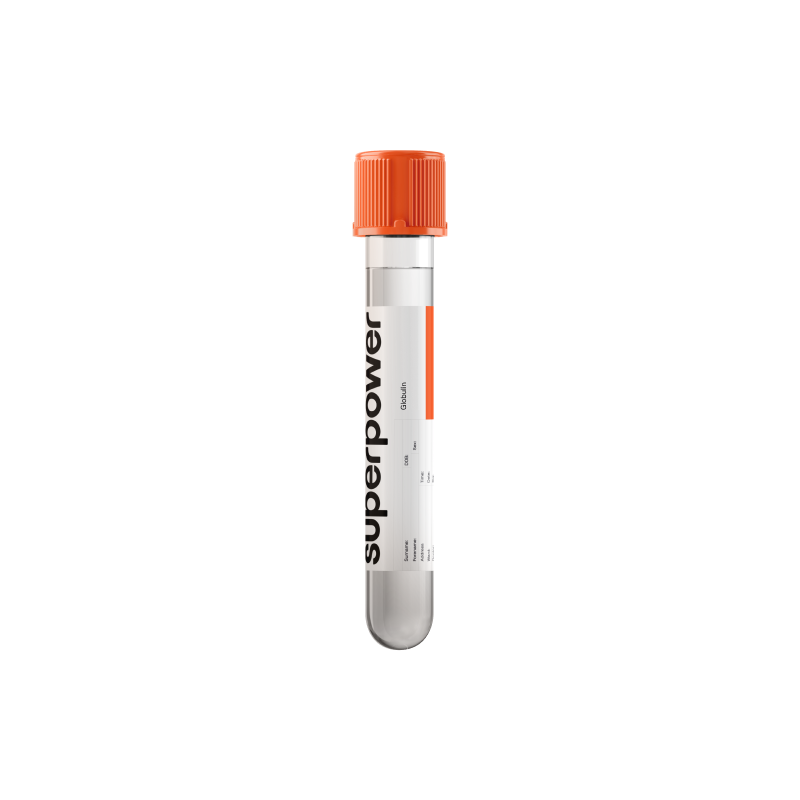Globulin testing captures the non-albumin proteins in your blood—key players in immune defense, transport, and inflammation control.
This single number, interpreted with albumin and the A/G ratio, helps reveal hidden shifts in protein balance, hydration, and immune activity.
Key Benefits
- Check immune-related blood proteins to assess inflammation, infection, and overall protein balance.
- Spot chronic inflammation or infection when globulins run high from immune activation.
- Flag plasma cell disorders, like multiple myeloma, when levels are markedly elevated.
- Explain recurrent infections by revealing low globulins suggesting possible antibody deficiency.
- Guide liver evaluation by indicating cirrhosis patterns when globulins rise and albumin falls.
- Clarify protein status with albumin to evaluate nutrition, dehydration, and protein-loss conditions.
- Track autoimmune or inflammatory disease activity and response to therapy over time.
- Best interpreted with albumin, total protein, A/G ratio, and protein electrophoresis if abnormal.
What is Globulin?
Globulin is not a single molecule but a family of proteins that circulate in your blood. Most are made by the liver (alpha and beta globulins), while your immune system makes the antibody portion (gamma globulins, or immunoglobulins). The liver also releases proteins that support immune responses and other functions (complement and various binding proteins). In lab reports, “globulin” refers to this non‑albumin protein fraction of serum.
Together, globulins do essential work: they ferry hormones, fats, vitamins, and minerals through the bloodstream (carrier proteins), defend against microbes (antibodies and complement), help coordinate inflammation, and participate in blood clotting (coagulation factors). Because these proteins come largely from the liver and the immune system, the overall globulin pool reflects the status of transport, immune activity, and other protective processes in the body. In short, globulin captures the body’s network of carriers and defenders operating in the blood.
Why is Globulin important?
Globulin is the family of blood proteins that carries hormones and metals, drives complement defense, and—most visibly—houses your immunoglobulins (antibodies). It links the immune system, liver synthesis, bone marrow activity, kidney filtration, and gut protein loss. Together with albumin it makes up total protein, and its balance signals whether the body is in steady repair or battling inflammation.
Most labs place globulin roughly in the 2 to 3½ range, with health generally clustering in the middle and remaining relatively stable over time. The albumin–globulin balance (A/G) often tells as much as the number itself.
When globulin runs low, it usually reflects fewer antibodies or loss/dilution of proteins. Bone marrow underproduction, congenital antibody deficiencies (more apparent in children), protein loss through kidneys or the intestine, or overhydration can all lower it. People may notice recurrent sinus or chest infections, poor wound healing, prolonged colds, or fatigue; kids can show frequent ear infections and growth setbacks. In pregnancy, hemodilution can nudge values down slightly without disease.
When globulin is high, the body is typically making many antibodies (polyclonal) in response to chronic infection, autoimmune disease, or liver inflammation—or producing a single clone (monoclonal) from plasma-cell disorders such as MGUS or multiple myeloma. Effects can include thickened blood with headaches or blurred vision, bone pain or anemia in marrow disorders, enlarged liver or spleen, and, paradoxically, more infections if normal antibodies are suppressed.
Big picture: globulin integrates immune readiness with protein transport and inflammatory tone. Interpreted alongside albumin, total protein, liver and kidney markers, and inflammatory tests, it helps map chronic inflammation, immune deficiency, or plasma-cell activity—signals that shape infection risk, organ strain, and long-term metabolic and hematologic health.
What Insights Will I Get?
Globulin reflects the non‑albumin proteins in blood—mostly antibodies (immunoglobulins) plus transport and complement proteins. It is a window into immune readiness, chronic inflammation, liver synthetic balance, protein nutrition, and fluid status. Together with albumin (the A/G ratio), it helps explain infection defense, wound repair, hormone and mineral transport, and blood viscosity.
Low values usually reflect too few immune proteins being made or too much being lost or diluted. This occurs with immune deficiency, protein‑losing kidney or gut conditions, advanced liver dysfunction, malnutrition, or overhydration. System‑level effects include reduced antibody reserve, higher infection susceptibility, and weaker mucosal defense. Infants naturally run lower; late pregnancy can show mild dilutional lowering.
Being in range suggests balanced immune activity without excess inflammation, adequate liver protein synthesis, sufficient dietary protein, and stable hydration. In healthy adults, the A/G ratio typically sits modestly above 1, and globulin near the mid‑range signals steady, resilient physiology.
High values usually reflect heightened antibody production from chronic infection, autoimmune activity, or chronic liver disease (polyclonal increase), or expansion of a single antibody clone (monoclonal gammopathy). Dehydration can concentrate proteins and transiently raise levels. System effects may include features of chronic inflammation (lower energy, malaise), and when markedly elevated, increased blood viscosity or neuropathic symptoms. In older adults, monoclonal causes become more common.
Notes: Many labs report calculated globulin (total protein minus albumin); electrophoresis shows patterns (alpha, beta, gamma) that refine interpretation and the A/G ratio. Pregnancy, age, acute illness, IV immunoglobulin, and immunosuppressive drugs influence results. Hydration status can shift values meaningfully.



.svg)



.png)
.png)
.png)
.png)








